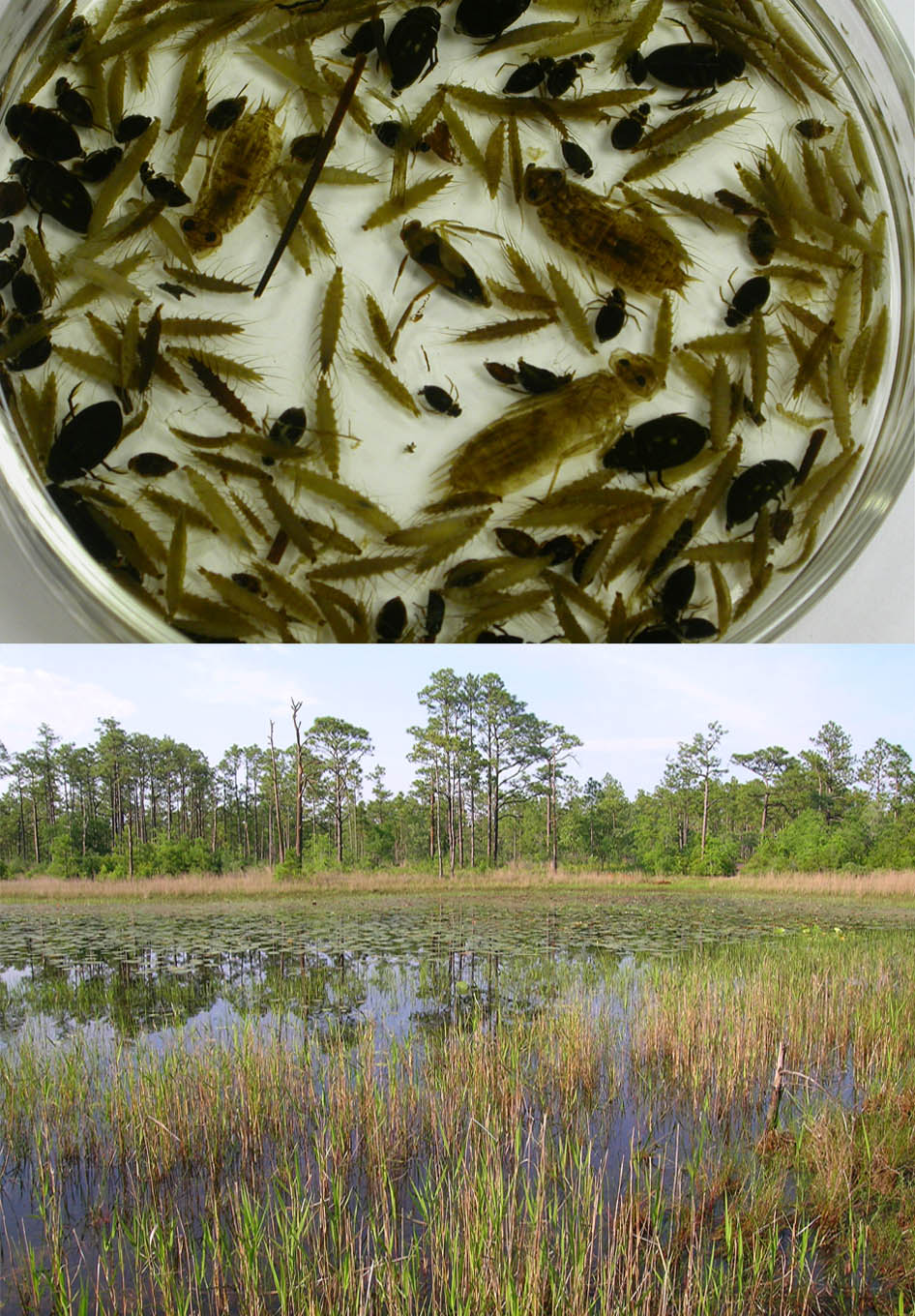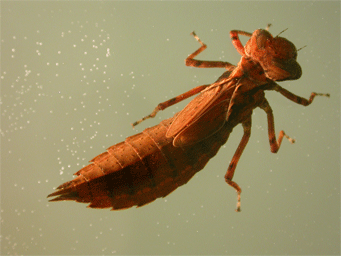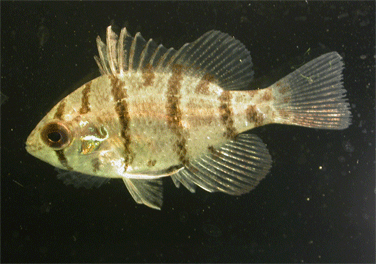Research
Research in our lab focuses on enhancing our understanding of processes controlling the
structure of ecological communities and how this structure affects ecosystem function and
dynamics of constituent populations. We are also interested in understanding processes that control the population size of species within ecological communities. Species interactions represent an important biological
process shaping ecological communities and our research attempts to enhance our
understanding of how biotic, abiotic, and historical factors generate variation in the intensity of
both predator-prey and competitive interactions. We employ experimental, ecoinformatic and
statistical approaches to achieve these goals. We have addressed conceptual ecological questions involving a variety of taxa (from animals to plants) in both freshwater and terrestrial ecosystems. Most of our field efforts focus on the ecology of temporary pond ecosystems; especially the animals within them.
 How is biodiversity distributed across the landscape?
How is biodiversity distributed across the landscape?
It is well recognized that biodiversity is not uniformly distributed across the landscape and much effort is directed toward identifying patterns in the distribution of biodiversity and understanding the mechanisms that produce them. Most studies, however, focus on identifying and explaining patterns associated with one measure of biodiversity, species richness, the number of species present in a location. We have explored spatial patterns involving multiple measures of biodiversity (e.g., species richness, species evenness, and species rarity).Our work has demonstrated that spatial patterns of different biodiversity metrics are largely independent of each other and that each responds to environmental factors in different ways. Currently, we are not only describing variation in the animal biodiversity among ponds in the Croatan National Forest but we are also conducting experiments to evaluate the consequences of this variation on these pond ecosystems. Furthermore, we are conducting experiments to evaluate how aquatic insect biodiversity is distributed among different terrestrial plant communities.
Are species substitutable for each other?
 A common assumption of many ecological theories and studies employing "functional groups" of
taxa is that species occupying similar trophic positions have similar effects on ecological
systems. We have conducted experiments to examine the extent of functional equivalence among
a suite ofaquatic predatory vertebrates that often occupy the top predator trophic position in
coastal plain ponds. We demonstrated that functional equivalence is not only
rare across a taxonomically broad group of organisms (fish and salamanders) that occupy a
similar trophic position in pond food webs but I also found little evidence of functional
equivalence among closely related species (all species of sunfish in the genus Enneacanthus).
These results indicate that it is unlikely that species remaining in the landscape following the
loss of some species will be able to adequately compensate for the lost species. Recently, we have completed work examining the extent to which native and introduced crayfish are substitutable in their effect. Furthermore, we have been assessing whether turtles have an important effect on the biodversity of aquatic insects in ponds.
A common assumption of many ecological theories and studies employing "functional groups" of
taxa is that species occupying similar trophic positions have similar effects on ecological
systems. We have conducted experiments to examine the extent of functional equivalence among
a suite ofaquatic predatory vertebrates that often occupy the top predator trophic position in
coastal plain ponds. We demonstrated that functional equivalence is not only
rare across a taxonomically broad group of organisms (fish and salamanders) that occupy a
similar trophic position in pond food webs but I also found little evidence of functional
equivalence among closely related species (all species of sunfish in the genus Enneacanthus).
These results indicate that it is unlikely that species remaining in the landscape following the
loss of some species will be able to adequately compensate for the lost species. Recently, we have completed work examining the extent to which native and introduced crayfish are substitutable in their effect. Furthermore, we have been assessing whether turtles have an important effect on the biodversity of aquatic insects in ponds.
Can we predict the effects of species on ecological systems on the basis of species traits?
 A major thrust in contemporary ecology is to develop a trait based approach to better predict the
effects of species on ecological systems. We have contributed to this effort by
conducting experiments designed to evaluate how variation in particular traits of predator
populations influence how predator populations affect their prey. For example, we found that traits
commonly used for identifying functional groups of predators are useful for identifying which
predator species will have a strong impact on some prey species but that the most useful trait
for identifying which predator species will have the strongest impact on a prey species varies
with prey species. We have also linked physiological models with models predicting the impact of
multiple predator species on their prey to better predict the impact of predator populations that
differ in population size and the average body size of individuals within the population. Our
results demonstrate that knowledge about the traits of the particular population occupying the
top predator trophic position can yield great insight into the effect of top predators on their prey.
A major thrust in contemporary ecology is to develop a trait based approach to better predict the
effects of species on ecological systems. We have contributed to this effort by
conducting experiments designed to evaluate how variation in particular traits of predator
populations influence how predator populations affect their prey. For example, we found that traits
commonly used for identifying functional groups of predators are useful for identifying which
predator species will have a strong impact on some prey species but that the most useful trait
for identifying which predator species will have the strongest impact on a prey species varies
with prey species. We have also linked physiological models with models predicting the impact of
multiple predator species on their prey to better predict the impact of predator populations that
differ in population size and the average body size of individuals within the population. Our
results demonstrate that knowledge about the traits of the particular population occupying the
top predator trophic position can yield great insight into the effect of top predators on their prey.
How does environmental variation affect how species interact?
The environment has long been known to influence the distribution and abundance of
organisms but surprisingly little work has examined how the environment affects the intensity in
which species interact. We have conducted field experiments to demonstrate that environmental
conditions modify the intensity of species interactions which can have important long term
effects on population dynamics. For example, we discovered that an increase in rainfall enhances
the ability of predatory ants to find and kill lizard eggs which provided an explanation for longterm
fluctuations in the population size of a lizard. Prior to our work, the primary mechanism
through which the environment was thought to affect species interactions was by directly
altering the abundances of the species involved in the interaction. Our work demonstrated that
the environment can alter the intensity of species interactions via another mechanism –
changing how intensely an average individual of one species affects population growth of a
second species. More recently, we have been completing projects that examine how food web complexity and habitat heterogeneity affect intraguild interactions between predatory larval dragonflies and salamanders, how temporal variation in the arrival sequence of species to local communities affect how strongly species interact with each other.
How effectively can we use small scale studies to accurately predict ecological phenomena at
larger scales?
A major issue in ecology focuses on translating results from small scale studies in less realistic
settings to a larger scale and a more realistic setting. We have been involved in a number of projects
that address this issue by synthesizing and analyzing data from multiple experiments and by
analyzing multi-scale, long-term data on plant communities collected by Long Term Ecological Research sites. For example, our work has shed light on our ability to predict the
consequences of nitrogen enrichment on plant species diversity at large spatial scales on the
basis of small scale responses to nitrogen enrichment. Recently, we have been exploring whether small scale experimental studies of artificially assembled plant communities adequately predict how biodiversity loss in naturally assembled plant communities affects ecological stability at different spatial scales.
